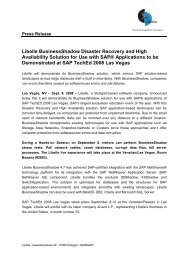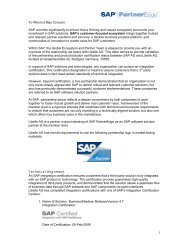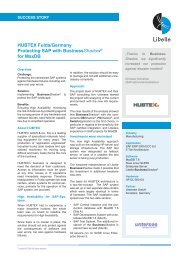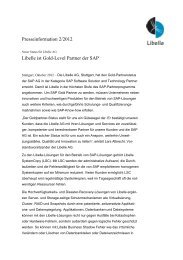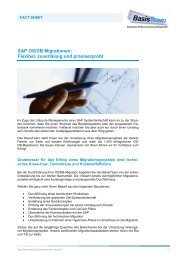Designing a bullet-proof Disaster Recovery Architecture for ... - Libelle
Designing a bullet-proof Disaster Recovery Architecture for ... - Libelle
Designing a bullet-proof Disaster Recovery Architecture for ... - Libelle
Create successful ePaper yourself
Turn your PDF publications into a flip-book with our unique Google optimized e-Paper software.
WHITE PAPER<br />
<strong>Designing</strong> a <strong>bullet</strong>-<strong>proof</strong> <strong>Disaster</strong> <strong>Recovery</strong><br />
<strong>Architecture</strong> <strong>for</strong> business-critical Applications<br />
While real disaster incidents are rare, the impacts are dramatic. What if your<br />
business-critical Application becomes unavailable? How much data would you<br />
lose? How much downtime can you af<strong>for</strong>d? Who would take responsibility?<br />
A functioning <strong>Disaster</strong> <strong>Recovery</strong> <strong>Architecture</strong> will make or break the survival of a<br />
business in a worst case scenario. This White Paper is aiding companies to<br />
design a practical and comprehensive architecture.<br />
We will outline essential project goals such as <strong>Recovery</strong> Point and <strong>Recovery</strong> Time<br />
objectives including ROI considerations and compare the pros and cons of three<br />
mainstream strategies. We close the 13 page paper with a modern-day approach<br />
to data mirroring which makes your architecture <strong>bullet</strong>-<strong>proof</strong>.<br />
<strong>Libelle</strong> AG. Authors: Lars Albrecht, Bernd Baier<br />
© <strong>Libelle</strong> AG. All rights reserved.
WHITE PAPER<br />
Contents Pages<br />
Why is <strong>Disaster</strong> <strong>Recovery</strong> still an Issue after all? .....................................................3<br />
Scope of a <strong>Disaster</strong> <strong>Recovery</strong> Project ........................................................................3<br />
<strong>Disaster</strong> <strong>Recovery</strong> Project Goals ................................................................................4<br />
<strong>Recovery</strong> Time and <strong>Recovery</strong> Point Objectives..........................................................4<br />
Transactional Integrity of Application Data..................................................................4<br />
Proof-of-Concept Objectives .......................................................................................5<br />
Return on Investment Goals........................................................................................6<br />
Simplicity Goals ...........................................................................................................6<br />
Bandwidth Requirements ............................................................................................6<br />
Three popular DR <strong>Architecture</strong>s <strong>for</strong> Applications .....................................................6<br />
Shipping Tapes to an off-site Location........................................................................6<br />
Block-Based Storage Replication................................................................................7<br />
Standby Databases .....................................................................................................8<br />
Using BusinessShadow ® <strong>for</strong> <strong>Disaster</strong> <strong>Recovery</strong>........................................................9<br />
Setting up a DR System with BusinessShadow ......................................................10<br />
Normal Mirroring Operation.......................................................................................11<br />
Switching to the <strong>Disaster</strong> <strong>Recovery</strong> Site ...................................................................11<br />
The BusinessShadow ® Advantage.............................................................................12<br />
Vendor Credentials and Live Demo Invite................................................................13<br />
Illustrations<br />
Illustration 1: <strong>Recovery</strong> Point and Time Objectives.....................................................4<br />
Illustration 2: Transactional Integrity of Application Data ..........................................5<br />
Illustration 3: Pros and Cons of Tape Restore .............................................................6<br />
Illustration 4: How distance reduces ROI when using block-based replication .......7<br />
Illustration 5: Pros and Cons of Storage Replication. .................................................8<br />
Illustration 6: Pros and Cons of Standby Databases...................................................9<br />
Illustration 7: Components of BusinessShadow ® .......................................................10<br />
Illustration 8: Screenshot of BusinessShadow ® mirroring Landscapes ..................12<br />
© <strong>Libelle</strong> AG. All rights reserved.
WHITE PAPER<br />
Why is <strong>Disaster</strong> <strong>Recovery</strong> still an Issue after all?<br />
Global dependencies on local application systems, the Sarbanes Oxley Act and threats<br />
due to natural disasters, power outages or acts of terrorism are the main market drivers<br />
<strong>for</strong> today’s DR Projects.<br />
Business needs and legal requirements are clearly demanding a functioning <strong>Disaster</strong><br />
<strong>Recovery</strong> concept. However, many companies still don’t have adequate mechanisms in<br />
place. A non-representative sample of 300 people attending Gartner Inc.’s Storage Show<br />
affirmed that 44% of attendees expressed that DR was still a project. Only two out of 300<br />
said that they per<strong>for</strong>m change control testing as part of DR1. This says a lot about the<br />
current state of <strong>Disaster</strong> <strong>Recovery</strong> Projects.<br />
Many companies seem to struggle in one way or another with DR. Even companies who<br />
do have architectures in place often lack proper testing. In other words: almost<br />
everybody is doing some kind of off-site backup or replication, but hardly anybody is<br />
having adequate testing procedures in place. In addition to presumably high costs and<br />
the time spent <strong>for</strong> planning and implementing a solution, the project won’t seem to<br />
deliver short-term benefits <strong>for</strong> the organization.<br />
There are, however, a small but growing number of companies and project managers<br />
who show a strong commitment when working towards their DR goals. The priorities in<br />
which DR projects are implemented are indicating how companies take responsibility<br />
towards their customers, their investors and their employees. A functioning <strong>Disaster</strong><br />
<strong>Recovery</strong> <strong>Architecture</strong> will make or break the survival of the business in a worst-casescenario.<br />
Scope of a <strong>Disaster</strong> <strong>Recovery</strong> Project<br />
We need to keep in mind that DR projects cannot be seen from a pure technical<br />
standpoint. It is the company’s business which is kept up and running after the disaster<br />
incident. Even if done right, providing <strong>for</strong> example a disk-mirrored SAN infrastructure is<br />
only one aspect of the project. Aside from additional technical details (Application system<br />
running on a different server, different license keys, DNS failover, application<br />
interdependencies …) there are crucial business questions to be answered:<br />
Who is in charge <strong>for</strong> DR? What constitutes a disaster? Who declares a disaster? Who<br />
updates the written DR Plan? Who is responsible <strong>for</strong> DR change management? How<br />
often per year are we conducting a DR test? What determines a “successful” DR test?<br />
The contents of these organizational aspects are as important as the technical<br />
infrastructure, but are not further detailed in this White Paper.<br />
1 Source: searchcio.techtarget.com/originalContent/0,289142,sid19_gci1195048,00.html<br />
© <strong>Libelle</strong> AG. All rights reserved. 3 / 13
WHITE PAPER<br />
<strong>Disaster</strong> <strong>Recovery</strong> Project Goals<br />
<strong>Recovery</strong> Time and <strong>Recovery</strong> Point Objectives<br />
Any DR project starts with the question of the potential data loss in case of a disaster<br />
(<strong>Recovery</strong> Point Objective or “RPO”) and the time necessary to have the systems up and<br />
running on the DR server (<strong>Recovery</strong> Time Objective or “RTO”).<br />
RPO = maximum acceptable RTO = maximum acceptable time until<br />
data loss in case of a disaster application is up on the DR system<br />
The target RPO and RTO values need to be determined by the business and weighed<br />
against the Return of Investment of the DR project. With an unlimited budget, companies<br />
would like to see RTO and RPO values of zero. Technical and budgetary reasons are<br />
however speaking against that. Is it reasonable to invest 5m$ to reduce the RPO from 10<br />
minutes to 1 minute with a disaster probability of 0.5% per given year? The following<br />
gives an illustration on calculating a Return on Investment with RPO and RTO in mind:<br />
– Estimated disaster probability in a given years = 2%<br />
– Estimated cost <strong>for</strong> data loss and downtime per incident = $15m<br />
– Probability × cost per incident = $300,000<br />
– Average cost of DR solution = $80,000 per year<br />
→ Cost of Avoidance Savings = $220,000 per year<br />
Transactional Integrity of Application Data<br />
Another goal of <strong>Disaster</strong> <strong>Recovery</strong> projects is to have the business data in the correct<br />
state upon switch-over. The term “transactional integrity” refers to the overall integrity of<br />
transactions from the point data is entered into an application down to the lowest<br />
granularity of a data block on a disk drive. The question of transactional integrity<br />
becomes an issue especially when replicating data on a storage-level (“block-level<br />
replication”) which is a popular method <strong>for</strong> local disaster protection <strong>for</strong> many customers.<br />
By definition, the further away we get from the initial transaction within the production<br />
system, the lower the transactional integrity. A confirmed storage-block transaction has<br />
Illustration 1:<br />
<strong>Recovery</strong> Point and<br />
Time Objectives<br />
© <strong>Libelle</strong> AG. All rights reserved. 4 / 13
WHITE PAPER<br />
only little to do with a confirmed application or database transaction. Storage blocks<br />
make up files, files make up databases, and databases contain data. While differences<br />
between every stage should be non-existent, they will show up in the big picture and<br />
particularly when mirroring data on a storage level versus mirroring data on a database<br />
level as DR architecture.<br />
Business-critical application(s)<br />
Online logs<br />
Offline logs<br />
Files<br />
Database<br />
Data files<br />
Files Files<br />
Server / Operating system<br />
Storage system / Storage blocks<br />
Database level<br />
File level<br />
Storage level<br />
As users enter data into the application, transactions move through the application system and<br />
the database server hands the transactions over to the database. The database makes sure<br />
that the transactions are logged properly <strong>for</strong> backup/recovery purposes and then hands them<br />
over to the file system. The file system then makes sure that the respective log files and data<br />
files are stored properly and can be accessed through the Operating System. Finally, the<br />
operating system hands the files to an internal or external storage controller which makes sure<br />
that the files are stored properly and can be accessed through storage blocks, the finest<br />
granularity in the whole process.<br />
Transactional integrity from the application perspective is critical <strong>for</strong> <strong>Disaster</strong> <strong>Recovery</strong><br />
because it determines in which state we will find our DR system after the production<br />
server becomes unavailable. It is critical because it determines if and when we get the<br />
application system up and running on the DR system after a disaster incident.<br />
Proof-of-Concept Objectives<br />
Any backup is only as good as the probability that the restore actually works. The same<br />
applies to DR. It would be a nightmare to invest hundreds of thousands of dollars in the<br />
project, only to learn that the application won’t start on the DR system in case of a<br />
disaster incident. It is imperative to insist that regular <strong>Disaster</strong> <strong>Recovery</strong> tests, which<br />
include the activation of the solution on the DR system, are being held.<br />
Well-tested and documented procedure with a good change management control using<br />
manual tape restore (low RPO, low RTO) is often of a higher overall value than a blockbased<br />
replicated architecture (high RPO, presumably high RTO) which was never tested<br />
but “should” work.<br />
Illustration 2:<br />
Transactional Integrity<br />
of Application Data<br />
© <strong>Libelle</strong> AG. All rights reserved. 5 / 13
WHITE PAPER<br />
Return on Investment Goals<br />
Any investment needs to bring returns <strong>for</strong> the business. To calculate the ROI exactly or<br />
to at least have an approximate calculation model, <strong>Disaster</strong> <strong>Recovery</strong> investments are<br />
typically compared to life insurance policies <strong>for</strong> a business. For calculating how much<br />
investment is justified, we determine how much coverage we need and how much we<br />
want to spend. The ROI calculation is then based on the cost of downtime <strong>for</strong> example<br />
on a per-day or on a per-hour basis and the actual risk of a disaster incident.<br />
Simplicity Goals<br />
Even small or medium sized application systems are complex. It takes only one critical<br />
component to fail <strong>for</strong> the whole system to malfunction. Redundancy of components will<br />
help a lot to cover outages of single components, but it is the complexity itself which<br />
often becomes a threat to the system. Additional components <strong>for</strong> <strong>Disaster</strong> <strong>Recovery</strong><br />
could make systems even more complex and vulnerable. A DR solution should be as<br />
simplistic as possible while providing the most comprehensive protection.<br />
Bandwidth Requirements<br />
The question of how much network bandwidth is reasonable, is another factor influencing<br />
the <strong>Disaster</strong> <strong>Recovery</strong> project. It is a huge difference cost-wise if we can <strong>for</strong> example<br />
mirror a 400 GB system using an 8 MBit/s WAN link when setting up a standby database<br />
versus having to invest in a 100 MBit/s WAN link <strong>for</strong> a block-based storage replication,<br />
especially since these are recurring monthly costs and will exponentially increase with<br />
the distance between the production and the DR system.<br />
Three popular DR <strong>Architecture</strong>s <strong>for</strong> Applications<br />
Most DR concepts fall into only three different categories:<br />
1. Shipping Backup Tapes to an off-site <strong>Disaster</strong> <strong>Recovery</strong> Location<br />
2. Block-based replication by storage hardware or other means<br />
3. Setting up standby databases with native database tools<br />
Shipping Tapes to an off-site Location<br />
<strong>Disaster</strong> <strong>Recovery</strong> with traditional tape backups is the strategy which most companies<br />
already per<strong>for</strong>m as part of their backup procedures. A tape backup is per<strong>for</strong>med to<br />
create a full copy of the database and files in regular intervals. Those tapes are then<br />
shipped to the designated DR location.<br />
Manual Tape Restore <strong>for</strong> <strong>Disaster</strong> <strong>Recovery</strong><br />
Pros Cons<br />
• High transactional integrity<br />
• Additional protection against user and<br />
software errors (Point-in-time <strong>Recovery</strong>)<br />
• Least expensive<br />
• High data loss in case of a disaster<br />
• Immense time required to restore data at off-site<br />
location<br />
• Manual procedures are time-intensive and bare<br />
the risks of human error<br />
Illustration 3:<br />
Pros and Cons of Tape<br />
Restore<br />
© <strong>Libelle</strong> AG. All rights reserved. 6 / 13
WHITE PAPER<br />
The advantages of this strategy are the minimal investment and no changes in<br />
technology since backup to tape is done anyway. The disadvantage is the very low RPO<br />
and RTO values: we would lose a lot of data and it typically requires days to be back up<br />
and running. Further, a lot of manual interventions are necessary <strong>for</strong> the restore. Many<br />
DR tests showed that no systems’ restore ever went flawless despite the fact that all<br />
involved parties are warned and prepared well ahead of an upcoming test.<br />
Block-Based Storage Replication<br />
Another popular DR architecture is to implement block-based storage replication. In this<br />
method, a second storage system is provided and every bit of data is synchronized to a<br />
remote location directly between two storage systems. Hardware and SAN providers<br />
typically promote this concept. It is tempting: every single bit of data is copied<br />
immediately to the <strong>Disaster</strong> <strong>Recovery</strong> site. If something goes wrong, we can simply flip<br />
the switch and continue to work with the solution on the DR site.<br />
There are of course stipulations attached to it. The multiple dedicated Fiber or ESCON<br />
lines necessary to keep the mirror in sync at any given time and proprietary hardware<br />
components will add enormous complexity to the systems. This will require a high initial<br />
and ongoing investment in bandwidth cost, maintenance and other resources.<br />
Less than<br />
1 Mile<br />
Less than<br />
5 Miles<br />
Less than<br />
100 Miles<br />
Network Latency, Costs,<br />
Bandwidth Requirements<br />
Return on<br />
Investment<br />
Less than<br />
500 Miles<br />
> 1000 Miles<br />
The biggest problem however is the distance since it is necessary to replicate every<br />
single bit of any transactions at any time. With larger distances, network traffic is largely<br />
consisting of overhead due to network latency. The larger the distance, the exponentially<br />
severe problems with network latency will get. The latest improvements in storage<br />
technology will only make a marginal difference.<br />
Finally, replicating every block on a storage system says nothing about data consistency<br />
of transactions from an application perspective. Such a replicated mirror can be<br />
consistent from a storage perspective (block-level consistency) and at the same time<br />
inconsistent from the application perspective (application-level consistency). Typical<br />
methods used to restore the application and database consistency are a database crashrecovery<br />
and files system checks.<br />
Illustration 4:<br />
How distance reduces<br />
ROI when using blockbased<br />
replication<br />
© <strong>Libelle</strong> AG. All rights reserved. 7 / 13
WHITE PAPER<br />
To cover the disadvantages, we see customers making compromises on their original<br />
distance goals so that the <strong>Disaster</strong> <strong>Recovery</strong> Server is only 5, 20 or sometimes 30 miles<br />
away from the production site in order to choose the block-based replication concept.<br />
Standby Databases<br />
Block-based Replication<br />
Pros Cons<br />
• “One size fits all”: One approach <strong>for</strong><br />
complete landscape if everything is<br />
centralized on one storage system/SAN<br />
• Storage replication software products are on<br />
the market <strong>for</strong> years and typically stable and<br />
mature.<br />
• Potential high <strong>Recovery</strong> Point Objectives<br />
(blocks are mirrored immediately<br />
synchronous or asynchronous)<br />
• Independent from the host server<br />
• Low transactional integrity on application/<br />
database level.<br />
• Typically requires two-identical storage systems<br />
or SAN components<br />
• Additional hardware components add complexity<br />
and additional risks<br />
• High network requirements even with new<br />
compression and asynchronous replication<br />
technologies<br />
• Low-span of control and transparency<br />
• Switch over, including tests manually or by shell<br />
script.<br />
• No protection against user and software errors<br />
(point-in-time recovery)<br />
• Switch-over has to be done manually with<br />
scripts<br />
• High Investments, typically starting at 500k$-<br />
700k$.<br />
Using standby databases <strong>for</strong> <strong>Disaster</strong> <strong>Recovery</strong> is the manual or half-automated process<br />
of setting up a standby database at a remote location by using scripts and/or tools which<br />
are part of the database.<br />
The popular databases such as DB2, Oracle, Microsoft SQL Server and MaxDB are<br />
providing more or less sophisticated tools enabling customers to build a basic standby<br />
database. The architecture is typically set up by assigning the project to an internal DBA<br />
or to an external consulting firm. In this scenario, database log files are continuously<br />
transferred to the DR site either with scripts or with automated tools. A mirror database<br />
would continuously receive database transactions which are then applied into a standby<br />
database.<br />
Illustration 5:<br />
Pros and Cons of<br />
Storage Replication<br />
© <strong>Libelle</strong> AG. All rights reserved. 8 / 13
WHITE PAPER<br />
Standby Databases<br />
Pros Cons<br />
• No additional costs <strong>for</strong> hardware, requires<br />
only a second server<br />
• Relatively low network requirements<br />
• High transactional integrity, only committed<br />
transactions are mirrored<br />
• Free database tool<br />
• No distance limitations<br />
The advantage of this method is that there seem to be only little financial investment<br />
required since scripts can be written in-house and the tools come typically free with the<br />
database. The method further provides a high level of transactional integrity especially<br />
compared to a block-based replication. Another advantage is that there are no distance<br />
limitation between the production and the disaster recovery location.<br />
One of the numerous disadvantages of standby databases is that only the database can<br />
be mirrored. Certain flat files which are important <strong>for</strong> the application system are very<br />
often not stored in the database and would not be available after a disaster.<br />
Another disadvantage is the lack of automation of standby tools coming with the<br />
database. The architecture depends heavily on the knowledge and availability of the<br />
database administrator. The staff dependency is not only an issue when setting up the<br />
DR mirror initially, but in particular when activating the mirror in case of a disaster<br />
incident.<br />
Using BusinessShadow ® <strong>for</strong> <strong>Disaster</strong> <strong>Recovery</strong><br />
• Database-centric approach which only covers<br />
the database but no flat files.<br />
• Single-database solution makes it impractical <strong>for</strong><br />
multi-database environment<br />
• Typically manual switch-over<br />
• No enhanced network optimization<br />
• No support <strong>for</strong> flat files<br />
• Potentially slightly lower RPO than hardware<br />
replication<br />
• Complex to set up, manage and operate;<br />
requires many manual intervention<br />
• High resource investment to maintain standby<br />
database scripts<br />
• High dependency on staff to execute the correct<br />
steps in case of a disaster<br />
• Lack of features and automation.<br />
BusinessShadow is seen by many as “the middle road” between block-based replication<br />
and standby databases. Compared to block-based replication, BusinessShadow doesn’t<br />
have any of the typical downsides such as lack of transactional integrity, overcoming<br />
large distances, excessive complexity or costs. Compared to standby databases it<br />
accommodates multi-database support, flat file mirroring, additional features and full<br />
automation of mirroring complete system landscapes.<br />
The core DBShadow ® component of BusinessShadow serves as a physical standby<br />
database while covering the missing features and the lack of automation of native<br />
standby tools. Other components will take care of the network optimization, the<br />
automation of the switch-over process and the handling of the flat files. Hundreds of<br />
Illustration 6:<br />
Pros and Cons of<br />
Standby Databases<br />
© <strong>Libelle</strong> AG. All rights reserved. 9 / 13
WHITE PAPER<br />
customers worldwide are using BusinessShadow ® <strong>for</strong> many years ranging from<br />
medium-sized to large enterprises mirroring complete landscapes with multiple<br />
terabytes.<br />
BusinessShadow consists of four different components:<br />
1. DBShadow ® to mirror the core databases which can be Oracle, MaxDB, DB2<br />
and MS SQL Server (or a combination of different databases)<br />
2. FSShadow ® to mirror flat files belonging to the application systems<br />
3. SwitchApplication to switch IP addresses and hostnames to the DR server<br />
4. Option Long Distance to optimize WAN traffic, cover network latency, compress<br />
files and ship IP packets parallel to the DR site.<br />
Setting up a DR System with BusinessShadow<br />
The only requirement to set up and operate BusinessShadow is a second server with<br />
the same operating system, the same disk space and a standard network connection.<br />
From a per<strong>for</strong>mance perspective, the mirror server requires enough per<strong>for</strong>mance to<br />
update changes during normal operation and adequate per<strong>for</strong>mance in case of an<br />
emergency to run the application.<br />
Our customers often use their test or backup systems as a DR server and temporarily<br />
shut down tests during the disaster incident.<br />
Illustration 7:<br />
Components of<br />
BusinessShadow ®<br />
© <strong>Libelle</strong> AG. All rights reserved. 10 / 13
WHITE PAPER<br />
Step 1: Initial Load to the DR Site<br />
Upon installation, we start with preparing the DR mirror by making a copy of the<br />
production system which is done during normal operation without interfering with<br />
production.<br />
Step 2: Archiver Process continuously ships changes to the DR Site<br />
In the next step, all committed transactions on the production system are continuously<br />
copied to the mirror server. Customers can specify the maximum archive switch time to<br />
define their <strong>Recovery</strong> Point Objective, <strong>for</strong> example every 5 or 10 minutes. Interruption<br />
due to temporary network, database, application or server outages on either site don’t<br />
require manual intervention. Enhanced WAN optimization comes with our Option Long<br />
Distance and is covering network latency and bandwidth issues.<br />
BusinessShadow ® is “the middle road” between block-based replication and standby<br />
databases. Compared to block-based replication, it doesn’t have any of the typical<br />
downsides such as lack of transactional integrity, overcoming large distances,<br />
excessive complexity or costs. Compared to standby databases it accommodates<br />
multi-database support, flat file mirroring, additional features and full automation of<br />
mirroring complete system landscapes.<br />
Step 3: Recover Process manages the DR Server<br />
In the next step we automatically apply the changes from the primary system to the<br />
secondary system which holds the copy of the database in loading mode. It is<br />
advantageous to wait a couple of hours be<strong>for</strong>e applying the changes to protect the mirror<br />
system against faulty transactions. If <strong>for</strong> example a batch job or malicious manipulation<br />
destroys the production database, the mirror database would still be valid and can be<br />
recovered to any desired time stamp be<strong>for</strong>e the point of destruction within minutes.<br />
Just as the initial copy, the recover process is fully automated and does not require any<br />
manual intervention or special database know-how. The mirror database is kept in a<br />
loading mode and changes are continuously applied. All mirroring parameters can be<br />
changed dynamically using the GUI or with a Command Line Interface.<br />
Normal Mirroring Operation<br />
Once the Initial Copy is per<strong>for</strong>med the mirror activated, we are in “normal operating<br />
mode” <strong>for</strong> <strong>Disaster</strong> <strong>Recovery</strong>. Changes are now continuously shipped to the DR server<br />
by the Archiver Process. The <strong>Recovery</strong> Process is either continuously applying those<br />
changes. The DR system is ready to take over with current data at any time. Please refer<br />
to Illustration 8 <strong>for</strong> a BusinessShadow GUI screenshot with mirroring a landscape of<br />
Oracle, MaxDB and UNIX flat files.<br />
Switching to the <strong>Disaster</strong> <strong>Recovery</strong> Site<br />
The only step necessary in case of a disaster is to instruct BusinessShadow to start up<br />
the mirror system, restart the application, eventually switch the IP address and we are up<br />
and running on our DR site. The switch-over process is handled smoothly and<br />
automated after the process is initialized by the customer: remaining changes are<br />
recovered; the database will be renamed to the correct name be<strong>for</strong>e it gets restarted.<br />
© <strong>Libelle</strong> AG. All rights reserved. 11 / 13
WHITE PAPER<br />
The FSShadow ® component covers flat files and SwitchApplication handles the IP<br />
addresses and hostname failover.<br />
The BusinessShadow ® Advantage<br />
In comparison to native standby database tools <strong>for</strong> <strong>Disaster</strong> <strong>Recovery</strong> we offer specific<br />
value in the following areas:<br />
• One solution <strong>for</strong> heterogeneous environments including, DB2, MaxDB, MS SQL<br />
Server, Oracle and available on all UNIX and Windows plat<strong>for</strong>ms.<br />
• Solution provides multi-plat<strong>for</strong>m support <strong>for</strong> heterogeneous systems on<br />
multiple database technologies such as an ECC system based on Oracle<br />
combined with an SAP APO/SAP liveCache based on MaxDB.<br />
• FSShadow/DBShadow ® combination support mirroring complete landscapes and<br />
not only a database.<br />
• No specific database know-how is required to set up and maintain the mirror and<br />
to switch the system in case of a disaster.<br />
• A dedicated “structure process” reflects new data files, new directories and nologging<br />
transactions on the secondary server.<br />
• The possibility of dynamic changes of all parameters via GUI keeps everything<br />
easy to operate.<br />
• SwitchApplication provides an automated switch of hostnames and IP<br />
addresses<br />
Illustration 8:<br />
Screenshot of<br />
BusinessShadow ®<br />
mirroring UNIX flat files<br />
and Oracle and MaxDB<br />
© <strong>Libelle</strong> AG. All rights reserved. 12 / 13
WHITE PAPER<br />
• The Option Long Distance provides massive network optimization including<br />
parallel archive shipping, high compression and the “Very Large Package<br />
Technology” to cover network latency <strong>for</strong> distances > 50 miles.<br />
• Automated switch-over interfaces <strong>for</strong> “Point-in-Time <strong>Recovery</strong>”, “Lossless<br />
Switching”, “Defined-Switching” and automated database rename.<br />
• Radical simplicity of the overall approach with independent server processes will<br />
make the DR architecture easy to operate on a day-to-day basis.<br />
Vendor Credentials<br />
<strong>Libelle</strong> is an established solution provider <strong>for</strong> high availability and disaster recovery<br />
located in Stuttgart, Germany. A strong team of experts provides years of experience<br />
and competences with a proven track record.<br />
Customers worldwide trust in the intelligent <strong>Libelle</strong> software solutions to protect and<br />
recover their business-critical data. <strong>Libelle</strong> customers benefit from excellent one-stop<br />
service as support, sales, and software development are all located in Stuttgart.<br />
The solutions are supplemented by a great service portfolio, ranging from the design and<br />
implementation of holistic HA and DR concepts to 24/7 support. Further, <strong>Libelle</strong> works in<br />
close partnership with all relevant hardware and software vendors and is certified per<br />
DIN EN ISO 9001:2008.<br />
More In<strong>for</strong>mation & Live Demo Invite<br />
Please contact us and sign up <strong>for</strong> a free and non-obligating 60-90 minute technical<br />
demo where we show you a live crash of a production system based on a database<br />
of your choice and address your questions.<br />
North- and South America All other Countries<br />
<strong>Libelle</strong> LLC <strong>Libelle</strong> AG<br />
3330 Cumberland Blvd. Suite 500 Gewerbestr. 42<br />
Atlanta, GA 30339-5997, USA 70565 Stuttgart, Germany<br />
T +1 770 / 435 1101 T +49 711 / 78335-0<br />
sales@us.libelle.com sales@libelle.com<br />
www.<strong>Libelle</strong>.com<br />
<strong>Libelle</strong> does not guarantee that the in<strong>for</strong>mation in this presentation is error-free. The liability <strong>for</strong> consequential or indirect damages arising out of the<br />
reading or the use of this in<strong>for</strong>mation is not warranted by <strong>Libelle</strong> AG within legal limits. All copyrights, especially distribution, reproduction and<br />
translation, are reserved. No part of this presentation may be reproduced (by photocopy, microfilm or otherwise), processed, reproduced or<br />
transmitted by electronic means without explicit approval of <strong>Libelle</strong>. Under no circumstances, including, but not limited to, negligence, shall <strong>Libelle</strong>,<br />
its agents or assignees, including but not limited to its parent, subsidiary, or affiliate companies, be liable <strong>for</strong> any direct, indirect, incidental, special or<br />
consequential damages that result from the use of the in<strong>for</strong>mation provided on this presentation. <strong>Libelle</strong>, the <strong>Libelle</strong> Logo, BusinessShadow ® ,<br />
DBShadow ® and FSShadow ® are trademarks of <strong>Libelle</strong> AG, Germany. All other mentioned products and companies in this White Paper are<br />
trademarks of their respective owners.<br />
© <strong>Libelle</strong> AG. All rights reserved. 13 / 13



